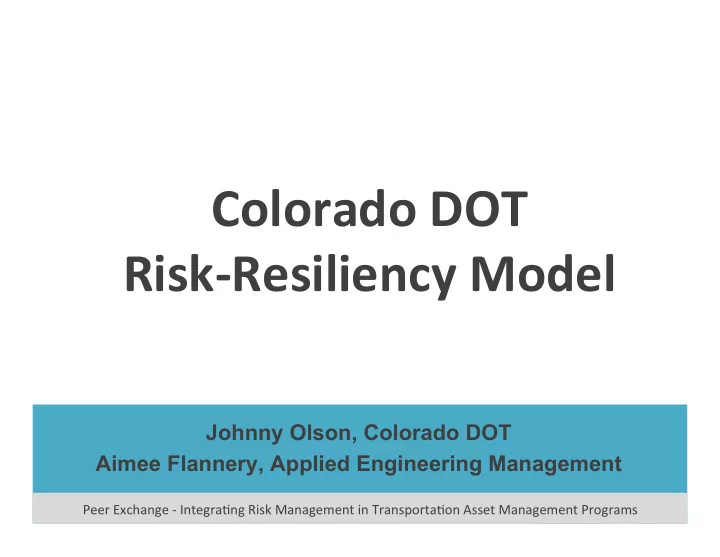

Colorado ¡DOT ¡ ¡ ¡ ¡ ¡ ¡ ¡ ¡ ¡ ¡ ¡ ¡ ¡ ¡ ¡ ¡ ¡ Risk-‑Resiliency ¡Model ¡ ¡ Johnny Olson, Colorado DOT Aimee Flannery, Applied Engineering Management Peer ¡Exchange ¡-‑ ¡Integra/ng ¡Risk ¡Management ¡in ¡Transporta/on ¡Asset ¡Management ¡Programs Peer ¡Exchange ¡-‑ ¡Integra/ng ¡Risk ¡Management ¡in ¡Transporta/on ¡Asset ¡Management ¡Programs
AASHTO Peer Exchange Johnny Olson, CDOT Region 4 Aimee Flannery, Applied Engineering Management Corp.
Initial 2013 Flood Impacts • $480 million estimated damage to facilities • $153 million estimated local costs • 486 Miles of state highway closed • 200+ Bridges and culverts damaged • 140,000 cubic yards of debris removed
CDOT and CWCB Hydrology Analysis
FHWA and CDOT Risk and Resiliency Pilot Resiliency Review Process • Assess risk • Assess vulnerability of assets • Estimate consequences • Criticality Score • Design alternatives
Repair Philosophy Original & Damaged Section
Typical Repair
Resilient Concept
Three pieces of information provided: 1. Measure of asset criticality to align ER program with typical CDOT investments 2. Annualized monetary risk for each asset from identified threats under current design standards (Restore in Kind) and with design improvements (Betterments) 3. Measure of resilience for each asset from identified threats under current design standards (Restore in Kind) and with design improvements (Betterments) 9
Asset Criticality Criticality Score • Provides context as to the effect a particular asset or facility has on the public and the agency • Each asset is scored on a five-point scale (1=Very Low Impact; 5=Very High Impact) for each criterion 10
Resilience Index Resilience ¡Index ¡ Criticality ¡Score Criticality ¡Level Score 4 ¡to ¡10 Low 1.0 11 ¡to ¡15 Moderate 2.0 16 ¡to ¡20 High 3.0
Quantifying Risk 12
Consequences to Consider • Human losses (death and/or injury) • Housing and public services/facilities losses • Revenue losses • Economic impacts • Environmental losses • Political considerations • Asset loss ($$) 13
Vulnerability Vulnerability – how vulnerable is an asset to an identified threat? Factors affecting vulnerability: • Asset age and condition • Countermeasures implemented to reduce vulnerability • Interdependence between on and off-system assets 14
US-34A MP 73.5 Damage (September 2013) Local Access Bridge 15
16
US-34A MP 73.5 Damage (September 2013) Downstream Local Access Bridge 17
Threats • Threats can range from political to natural • Efforts to date focused on natural threats within context of asset geographic location • Typical threats analyzed in risk assessment: • Flooding • Wind • Earthquakes • Avalanche • Tornados • Fire • Storm surge/Hurricanes • Cascading effects of threats – example burn/flooding 18
Measure of Resilience Resilience = AADT × % AADT Not Serviced × Days Out of Service × V × T Resilience = potential number of vehicles affected by threats in a given year (veh) % AADT Not Serviced = based on expected number of lanes closed V = vulnerability to identified consequences under a specific threat (probability) T = specific threat likelihood (probability) 19
Example Application of Risk and Resilience Process US 34 MP 66.61 – MP 78.63
Flo Flood ¡Z d ¡Zone ¡f ne ¡for ¡I-‑34 ¡Co r ¡I-‑34 ¡Corrido rridor ¡f r ¡for ¡100yr ¡e r ¡100yr ¡even ent ¡( t ¡(HAZUS HAZUS-‑ -‑ MH MH) ) LAC ¡at ¡MP ¡75 ¡ Local ¡Access ¡Point ¡(LAC) ¡at ¡MP ¡67 ¡ C-‑17K ¡& ¡LAC ¡at ¡MP ¡76 ¡ LAC ¡at ¡MP ¡74 ¡ 21
Example Application of RnR for US 34 Hydraulic ¡ Total ¡ Annualized ¡ Design ¡ Design ¡ Project ¡ Cost Cost ¡Above ¡ Annualized ¡ Alternative (year) Cost Above ¡PR PR, ¡C Benefit, ¡B B/C Risk B/C RnR Total ¡ =$50,848,500 Restore-‑in-‑Kind ¡ ER=$17,347,300 (ER+PR) 25 PR=$33,501,200 $0 $0 $0 N/A N/A Replace ¡to ¡ Standard 25 $55,562,500 $22,061,300 $757,491 $629,086 0.83 1.66 Design ¡ Alternative ¡A 50 $54,115,300 $20,614,100 $707,800 $693,313 0.98 1.96 Design ¡ Alternative ¡B 100 $58,622,700 $25,121,500 $862,565 $705,585 0.82 1.64 Design ¡ Alternative ¡C 50 $54,602,000 $21,100,800 $724,511 $726,730 1.00 2.01
23
Risk Analysis and Management for Critical Asset Protection (RAMCAP) 24
25
Colorado Resiliency Project Why now: • Major impacts from hazards in the last five years • Continued expectation that hazards will occur and potentially increase due to changing climate patterns • Opportunity to learn lessons from past disasters • Opportunity to build back in a way that makes us stronger • Opportunity to integrate Resiliency into future community development and our every-day lives
Colorado Resiliency Project • One-Year Report • Engagement and Community Outreach • Colorado Resiliency Resiliency Framework Working Group • Peer Review • Resilience Heroes • NDRC Application • CDBG-DR www.coloradounited.com/resilient
Colorado Resiliency Framework • Resource for local governments, businesses, non- profits and individuals • Support and cultivate a culture of resilience at the state and local level • Empower the whole community and tap into a sense of personal responsibility that defines us as Coloradans . • Integrate resiliency into our every-day way of life.
Colorado Resiliency Framework • Sector Overview • Shocks and Stresses • Problem Statements • Strategies and Goals • Cross-Sector Integration
Colorado Resiliency Framework Example Sector Overview Shocks • Damaged or destroyed infrastructure • Inaccessible infrastructure Stresses • Increased demand • Long term wear and tear on infrastructure • Changing climate conditions Example Strategies • Evaluate Infrastructure risks to determine comprehensive approach to hazards • Develop policies that a stakeholder / interagency approach should be taken for infrastructure design and construction projects to ensure that all interested parties are involved
CDOT Risk and Resiliency How is CDOT going to incorporate resiliency into day to day operations? • Risk and Resiliency Analysis Tool • Asset Management • Project Management
Outstanding Concerns • Why doesn’t transportation have an industry standard for analyzing risk and resilience of highway assets? • An industry standard would help: • standardize definitions of key terms (resilience, hazard, risk, etc.) • provide agencies with a series of lookup tables to assess anticipated losses from identified threats to specific assets
Questions? Thank you!
Recommend
More recommend